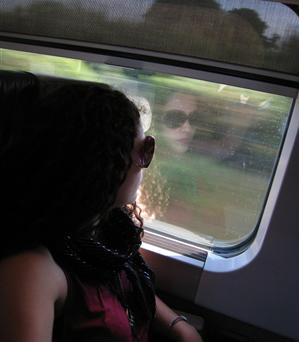What happens to phone booths when everyone has phones in their pockets? Photographer Sarah Berry’s new exhibit, now up at Trident Booksellers & Cafe on Newbury Street, examines that question and the fate of other unused objects. She’s a world traveler who has been taking photographs since she was 7. She has also led photography workshops for adults and children. I asked her about her new exhibit, which runs until March 17, and her favorite places to travel.
Tell me about your new show that’s up at Trident Cafe.

I am also showing some new work in which I combine my photography with found objects. The objects are things I didn’t have the heart to throw in the garbage, or they were crowd-sourced (thank you, friends!). In most cases, the work is the result of pairing the object—empty tea-light holders, the leftover plastic compasses I handed trick-or-treaters, an old window—with an image from my collection to tell a story about ways objects were used and where they came from. The process is new for me and I am very excited about it.
It looks like your work focuses less on people and more on objects. Was that a conscious decision?
The work in this show is about people: what we make and the things we leave behind. Empty phone booths are how we used to conveniently talk to others while we were in public spaces. They’re just a flash in our history, and I’m curious how long their useless, bulky husks will hang around. That answer is up to people, too.
You’ve done a ton of world traveling. What’s been your favorite country to visit and photograph? Or are those two separate countries?
I feel noncommittal to one favorite, mostly because so much of my travel happened when I was a kid. I lived in Seoul, Korea, between the ages of 2 and 5. I know my experiences are in there somewhere, just not in many of my memories. I’m partial to the Mediterranean. I speak Spanish, Italian and some French, and I love immersing myself in them. I lived in Rome for my four years of high school, and that’s where I fell in love with taking pictures. Lately I’ve been drawn to Spain. I’ve been there three times since 2005 and plan to return soon. Aside from the fact that I got a picture of an empty phone booth in front of Roy Lichtenstein’s “El Cap de Barcelona” (now showing downstairs at the Trident), I am extremely interested in how Jewish arts and culture is surfacing and percolating in a place where it was suppressed for thousands of years.
Crash-course time: When you lead a photography workshop, what’s the most important thing you like for your students to learn?
Even if you’re looking through the viewfinder or screen of a camera without a detachable lens, don’t point and shoot. Stop and look.
*Photo: Sarah Berry’s self-portrait, 2010

This post has been contributed by a third party. The opinions, facts and any media content are presented solely by the author, and JewishBoston assumes no responsibility for them. Want to add your voice to the conversation? Publish your own post here. MORE


